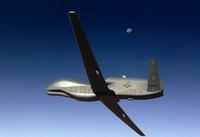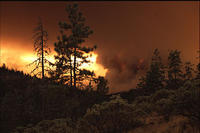-
Smaller asteroids could cause bigger problems

On 15 February an asteroid burst over the Russian city of Chelyabinsk. Scientists estimate that the Chelyabinsk event was equivalent to an explosion of about 500 kilotons of TNT. At its peak, the airburst appeared to be thirty times brighter than the sun. The asteroid fireball that injured about 1,500 people and damaged more than 7,000 buildings, collapsing roofs, and breaking thousands of windows. Scientists say that because the frequency of a strike of an asteroid of this size has exceeded expectations, with three such strikes in just over a century – Chelyabinsk in 2013, Tunguska in 2008, and a large airburst in the South Atlantic in 1963 — the number of similar-sized asteroids capable of causing damage may be greater than suspected.
-
-
Study finds more spending on fire suppression may lead to bigger fires
Researchers found that fire management can fall into the firefighting trap: Energy and resources are spent mostly on fire suppression — putting out fires in the moment — while less attention is devoted to fire prevention, such as clearing brush and building fire lanes during the off-season. After severe fires, policymakers funnel even more funds into fire suppression for the next season, but this attention to fire suppression may undermine prevention efforts. The result, counterintuitively, is even worse fires the following season, due to the buildup of fire-prone materials such as dried tinder and dead trees. The researchers emphasize balancing fire suppression with prevention measures.
-
-
Evacuation modeling: finding the best time (and way) to get going
Reports from the Philippines reveal a lack of typhoon preparation and evacuation efforts. When to evacuate — and how – could spell the difference between life and death. Typhoons can cause widespread flooding of surrounding areas, and do not just affect what lies in the path of the storm. Planning an evacuation is a game against nature. Few plans are safe, and the number and complexity of decisions quickly becomes overwhelming — especially as rising water or traffic accidents block roads — but computers can dramatically help emergency services design evacuation plans which people can actually follow.
-
-
Detecting radioactive material in nuclear waste water
As the Fukushima crisis continues to remind the world of the potential dangers of nuclear disposal and unforeseen accidents, scientists are reporting progress toward a new way to detect the radioactive materials uranium and plutonium in waste water.
-
-
Global disaster recovery as a service: market trends 2014-18
Reportstack has announced a new market report on Global Disaster Recovery-as-a-Service Market 2014-2018, which forecasts that the market is expected to grow at a CAGR of 54.64 percent over the period 2014-2018.
-
-
New drone to monitor radiation following nuclear disasters

Researchers have unveiled a large semi-autonomous drone called the ARM system which could be used to provide visual and thermal monitoring of radiation after a release of nuclear material. The system was developed in response to requirements for radiation monitoring in event of the release of radioactive materials.
-
-
Forecasting long-lived wildfires

Scientists have developed a new computer modeling technique that offers the promise, for the first time, of producing continually updated daylong predictions of wildfire growth throughout the lifetime of long-lived blazes. The technique combines cutting-edge simulations portraying the interaction of weather and fire behavior with newly available satellite observations of active wildfires.
-
-
The Philippines is victim of geography, poor infrastructure, poverty
Owing to its location and geography, the Philippines is one of the most natural disaster-prone countries in the world. On average the country experiences nine major typhoons and 900 earthquakes annually, and it has twenty-five active volcanoes. Poor infrastructure and pervasive poverty exacerbate the impact of disasters, making them even more deadly and destructive. “In a cruel cycle, poverty and underdevelopment make disasters worse, and disasters make poverty and underdevelopment worse,” one observer notes.
-
-
Past as prologue: Insights from past natural disasters relevant today
The increasing frequency and intensity of natural disasters constitute a daunting challenge to modern society, which is characterized by a heavy infrastructure and increasing population density. Until now, coping with natural disasters has involved expensive state intervention and technology-aided approaches, but researchers believes that the past contains a wealth of unexploited resources which could also provide solutions to the problems communities face when dealing with need to cope with, and recover from, natural disasters.
-
-
Japan hopes off-shore wind turbines can replace shut-down nukes

Japan inaugurated a floating offshore wind turbine on Monday, symbolizing the country’s effort to reduce its dependency on nuclear energy and fossil fuels and shift to renewable energy sources. The floating platform is anchored thirteen miles offshore from the Fukushima Daiichi nuclear power plant, which has been out of commission since the reactor’s meltdown disasterof March 2011. The platform is anchored to the seabed 400 feet below surface. It is the first project of its kind in Japan, and it aims to show that the country can exploit the country’s powerful offshore winds to create a sustainable energy source.
-
-
Calif.’s earthquake early warning system bill approved
California’s earthquake early warning system, State Senate Bill 135, was approved by Governor Jerry Brown. The bill requires the Office of Emergency Services (OES) to develop a comprehensive statewide earthquake early warning system to alert Californians in advance of shaking from an earthquake.
-
-
National grid in mock power emergency drill today and tomorrow
North American power companies will participate in a mock power emergency scenario today and tomorrow (13-14 November) to test their ability to respond to physical or cyberattacks that may lead to widespread power outages and long term blackouts. The exercise, known as GridEx II, is the second emergency response exercise conducted by North American Electric Reliability Corporation (NERC) intended to task North American electric utility companies with reviewing their security and crisis response strategies.
-
-
Philippines prepares for worse disasters to come
On average, the Philippines experiences about twenty typhoons a year, including three super-typhoons and many incidents of flooding, drought, earthquakes, tremors, and occasional volcanic eruptions, making the country one of the most naturally disaster-prone areas in the world. Filipino government agencies, with the help of international disaster and relief agencies, have created new strategies for disaster preparedness, response, and mitigation which may well have potential applications in other parts of the world. As the impact of climate change grows more pronounced, the Philippines is becoming a hothouse for developing new methods and systems in the growing business of disaster relief.
-
-
Sunlight-activated nanogrid breaks down pollutants in water
Oil spills do untold damage to the environment — to the waters they pollute and to marine and other wildlife. The Deepwater Horizon spill in the Gulf of Mexico in 2010, for example, the largest accidental marine oil spill in the history of the petroleum industry, flowed unabated for three months. Typically, such oil spills are extraordinarily difficult to clean up. Soon, however, the process may become infinitely easier and ecologically friendly, the result of a new invention — “nanogrid” — a large net consisting of metal grids made of a copper tungsten oxide, that, when activated by sunlight, can break down oil from a spill, leaving only biodegradable compounds behind.
-
-
Chelyabinsk meteor explosion a "wake-up call," scientists warn
Three new studies have revealed details of the meteor that exploded above Russian city, Chelyabinsk, in February this year. Their findings provide information about the meteor’s origin, trajectory, power and damage by the airburst (the shock wave that travelled through the air from the explosion). These findings may help to refine theoretical models about the likely frequency of such events, the potential damage they could cause and hazard mitigation strategies needed for planetary protection.
-
More headlines
The long view
Trump Aims to Shut Down State Climate Policies
President Donald Trump has launched an all-out legal attack on states’ authority to set climate change policy. Climate-focused state leaders say his administration has no legal basis to unravel their efforts.
